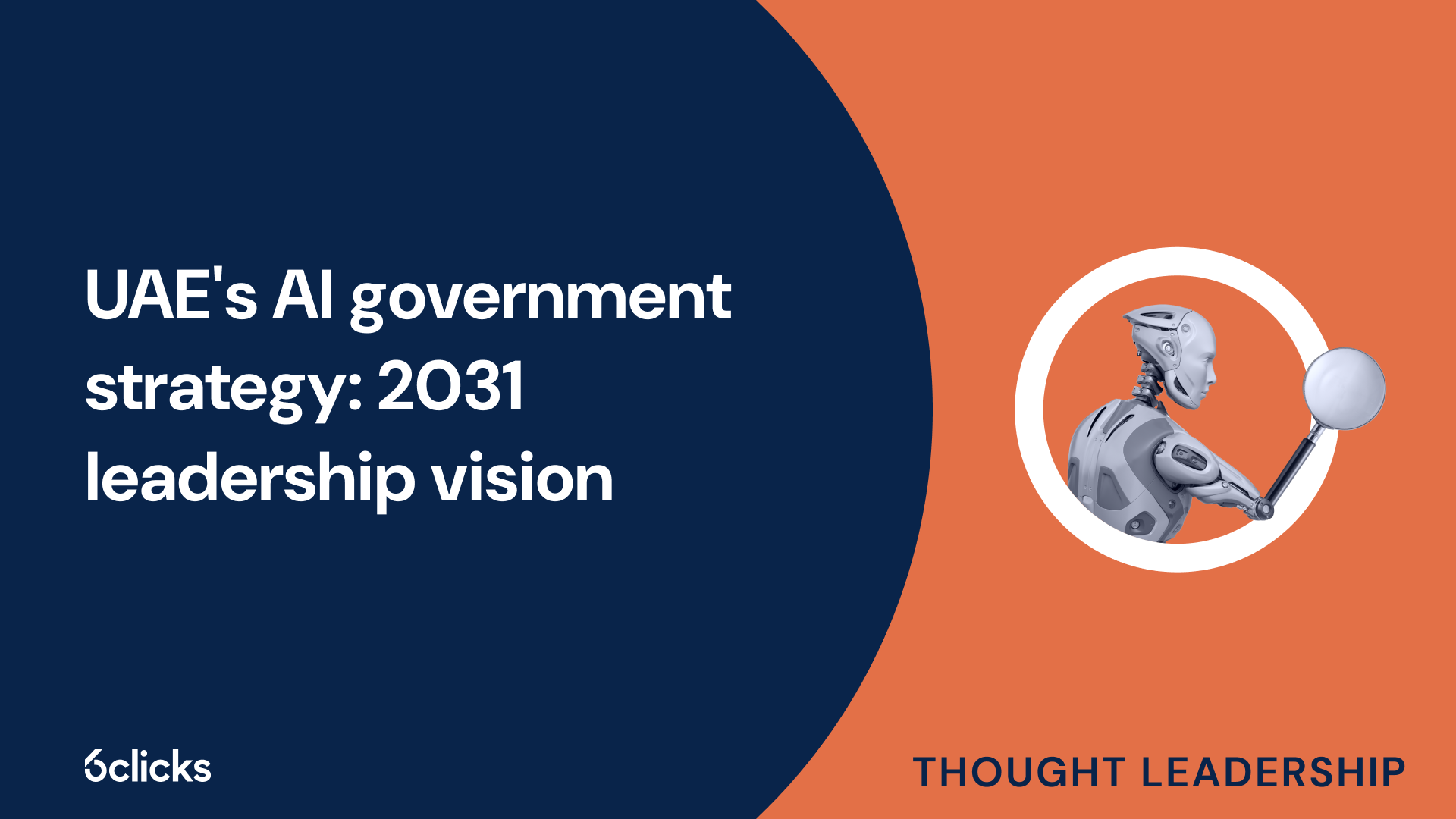
The UAE National Strategy for Artificial Intelligence 2031 represents a watershed moment in governmental digital transformation, positioning the nation to become a global AI leadership hub. With ambitious targets to generate AED 335 billion in additional economic growth by 2031, the strategy encompasses comprehensive investments across education, smart governance, and AI ecosystem development. Government entities are now transitioning from strategic planning to operational implementation, requiring sophisticated frameworks that can balance innovation with robust risk and compliance management. Let's explore further what this means for technology providers and AI leaders who are key to helping the UAE government realize this vision.
UAE's 2031 AI vision: From blueprint to implementation reality
The strategy's eight strategic objectives focus on building AI reputation, increasing competitive assets in priority sectors, developing a fertile AI ecosystem, and establishing world-leading research capabilities. For UAE government technology leaders, this translates into immediate requirements for integrated governance frameworks that can support rapid AI adoption while maintaining security and compliance standards. The challenge lies in transforming theoretical blueprints into practical, scalable solutions that align with both national objectives and international best practices.
Cybersecurity imperatives: Protecting digital assets in an AI era

Recent cybersecurity assessments reveal that over 223,800 digital assets hosted within the UAE are potentially exposed to cyberattacks, with half of critical vulnerabilities remaining unaddressed. The State of the UAE Cybersecurity Report 2025 by the Cyber Security Council UAE highlights a 58% surge in ransomware activity, driven by sophisticated AI-powered threats, including deepfake-driven social engineering attacks and autonomous malware capable of navigating networks independently. With AI-powered threats evolving beyond traditional defenses, government technology leaders face a dual mandate: accelerate AI adoption while ensuring resilience against an unprecedented cyber risk landscape.
The convergence of AI adoption with escalating cyber threats creates unique challenges for public sector organizations. Ransomware-as-a-service groups like LockBit, RansomHub, and Medusa are deploying AI-enabled ransomware that adapts in real-time to evade traditional defenses. Government entities must now protect not only conventional IT infrastructure but also emerging AI systems that present new attack vectors. The integration of AI-driven security measures with comprehensive governance frameworks becomes essential for maintaining national security while pursuing digital transformation objectives.
Integrated AI-GRC framework: Balancing innovation with risk management

The demand for integrated AI Governance, Risk, and Compliance (AI-GRC) frameworks has never been more critical as UAE government entities navigate the complexity of simultaneous AI adoption and threat mitigation. These frameworks must address AI-specific risks including algorithmic bias, data privacy vulnerabilities, security breaches, and evolving regulatory requirements. According to recent analysis, organizations implementing comprehensive AI-GRC frameworks report 40% faster incident response times and 60% reduction in compliance-related operational overhead.
Effective AI-GRC frameworks enable proactive risk identification, assessment, and mitigation while supporting innovation objectives outlined in the national strategy. Key components include automated compliance monitoring, real-time risk analytics, and predictive threat modeling powered by machine learning algorithms.
By embedding AI governance into existing risk management systems, government entities can create adaptive frameworks that evolve with both technological advancements and threat landscapes, ensuring sustainable AI adoption aligned with national security priorities.
Smart governance evolution: AI-enabled decision making with compliance
The transformation toward smart governance represents a fundamental shift in how UAE government entities deliver services and make decisions. AI-enabled governance systems are revolutionizing everything from citizen services to policy formulation, with implementations ranging from predictive analytics for resource allocation to automated compliance validation across departments. The National Cybersecurity Strategy 2025-31 emphasizes the critical need for governance frameworks that can support these innovations while maintaining security and public trust.
Successful smart governance implementation requires more than technological deployment; it demands cultural transformation and process reengineering. Government leaders must foster environments where AI augments human decision-making rather than replacing it, ensuring accountability and transparency remain paramount. This integration enables government entities to maintain continuous compliance monitoring while accelerating service delivery innovations, creating a sustainable foundation for long-term digital transformation success.
Strategic implementation: Building resilient AI infrastructure for government
Building resilient AI infrastructure requires government entities to adopt a multi-layered approach encompassing technical architecture, governance processes, and human capabilities. The UAE's commitment to AI leadership, exemplified by projects like the Stargate initiative, demands infrastructure that can support both current implementations and future innovations. This includes secure data sharing environments, AI test beds for experimentation, and robust backup systems ensuring continuity of critical government services.
Implementation strategies must prioritize scalability and interoperability, enabling seamless integration across government departments while maintaining security boundaries. Key considerations include:
- Establishing AI Centers of Excellence within government entities
- Developing standardized APIs for cross-department AI services
- Implementing zero-trust security architectures
The adoption of cloud-native AI platforms with built-in governance controls accelerates deployment timelines while ensuring compliance with national data sovereignty requirements and international security standards.
This is where 6clicks can play a pivotal role. As a sovereign, AI-powered GRC platform, 6clicks equips UAE government entities with built-in frameworks, automated compliance mapping, and real-time risk analytics — all designed to meet local regulatory requirements while aligning with global best practices, including ISO/IEC 42001 for responsible AI governance. With its Hub & Spoke architecture, government departments can scale AI initiatives securely across multiple entities, maintaining centralized oversight while enabling local autonomy. By embedding governance and assurance into every stage of AI adoption, 6clicks helps transform compliance from a bottleneck into a catalyst for innovation.
Final thoughts: Future-proofing UAE's AI leadership through governance excellence
Sustaining AI leadership requires continuous evolution of governance frameworks that can adapt to emerging technologies and threats. The UAE's vision for 2031 depends on establishing governance structures that promote innovation while maintaining public trust. This includes developing AI ethics committees within government entities, establishing clear accountability frameworks for AI decision-making, and creating feedback loops that enable continuous improvement of AI systems based on operational experience.
Looking ahead, UAE government entities must prepare for next-generation challenges including quantum computing threats, advanced persistent threats enhanced by AI, and evolving international AI regulations. Success requires building adaptive governance capabilities that can respond to unknowns while maintaining operational stability. By transforming compliance from operational overhead into a strategic enabler, government technology leaders can ensure the UAE not only achieves but exceeds its 2031 AI leadership aspirations, setting new global benchmarks for responsible AI governance in the public sector.


